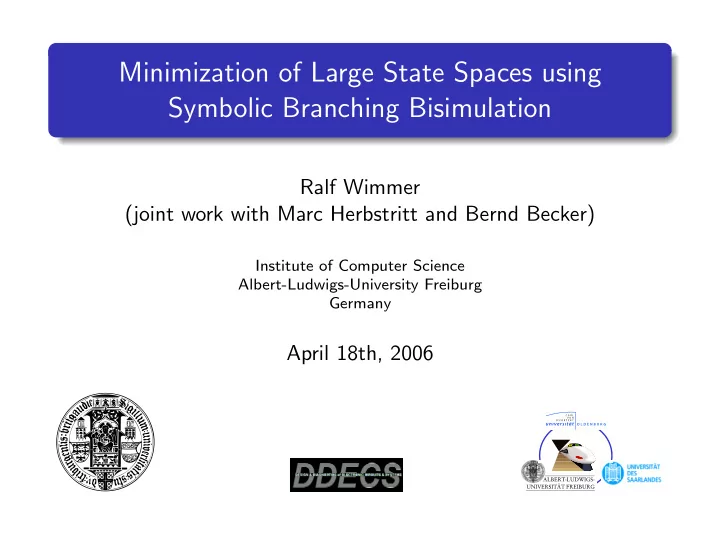

Minimization of Large State Spaces using Symbolic Branching Bisimulation Ralf Wimmer (joint work with Marc Herbstritt and Bernd Becker) Institute of Computer Science Albert-Ludwigs-University Freiburg Germany April 18th, 2006
Introduction Symbolic Computation Experimental Results Further Work Safety-critical Systems Quantitative Analysis for safety-critical systems:
Introduction Symbolic Computation Experimental Results Further Work Toolflow Statemate Small description Huge symbolic explicit LTS Safety LTS requirements Symbolic Minimization Transformation Afterwards: Addition of stochastic information and application of stochastic model checking.
Overview Introduction 1 Why Symbolic Branching Bisimulation? Labeled Transition Systems Branching Bisimulation Symbolic Computation 2 Symbolic Representation of LTS, Partitions and Signatures Computation of the Signatures Refinement Experimental Results 3 Further Work 4
Introduction Symbolic Computation Experimental Results Further Work Why Symbolic Branching Bisimulation? Nominal behaviour is irrelevant. ⇒ LTS with “unobservable” τ -actions. Branching Bisimulation preserves all interesting properties (CTL* \ X) makes use of τ -actions.
Introduction Symbolic Computation Experimental Results Further Work Labelled Transition System A labelled transition system M is a triple M = ( S , A , T ): τ b s 2 s 1 s 3 τ a a b τ s 4 s 5 s 6 τ τ a τ τ s 8 s 9 s 7 τ a
Introduction Symbolic Computation Experimental Results Further Work Branching Bisimulation An equivalence relation B is a branching bisimulation if for all → s ′ implies: a ( s , t ) ∈ B s − a s s ′ τ s s ′ or τ ∗ t t a t ′ t ′′ B i B i B k
Introduction Symbolic Computation Experimental Results Further Work Example: Branching Bisimulation τ b s 1 s 2 s 3 τ a b a τ s 4 s 5 s 6 τ τ a τ τ s 8 s 9 s 7 a τ
Introduction Symbolic Computation Experimental Results Further Work Signatures Signature = set of pairs ( action a , block B ) meaning: “With the action a you can go to the block B under certain conditions”. ( a , B k ) ∈ sig( s ) iff B k B j τ s ′′ a τ s ′ s a � = τ ∨ B i � = B j
Introduction Symbolic Computation Experimental Results Further Work Refinement The states are grouped according to their signatures: sigref( π ) = {{ t ∈ S | sig( t ) = sig( s ) } | s ∈ S } Iteration to the fixpoint yields the coarsest branching bisimulation.
Introduction Symbolic Computation Experimental Results Further Work Symbolic Representation Unique numbers are assigned to each block of the current partition π = { B 0 , . . . , B m − 1 } . BDD representation state space: S ( s ) = 1 iff s ∈ S a transition relation: T ( s , a , t ) = 1 iff s − → t partitions: P ( s , k ) = 1 iff s ∈ B k . signatures: σ ( s , a , k ) = 1 iff ( a , B k ) ∈ sig( s ).
Introduction Symbolic Computation Experimental Results Further Work Signatures Formal Definition sig( s ) = { ( a , B ) | ∃ s ′ , s ′′ ∈ S : s τ ∗ → s ′′ ∈ B ∧ ( a � = τ ∨ s �≡ π s ′′ ) } a − → s ′ − π The signatures can be computed using standard BDD operations: Boolean connectives existential quantification reflexive transitive closure Problem Efficient implementation of the refinement operator is not possible using standard BDD operations. How can it be done efficiently?
Introduction Symbolic Computation Experimental Results Further Work Refinement (1) Observation Assuming the variable order s i < a j ∧ s i < k l . Then each signature is represented by a unique node of the BDD. Idea Substitute these signature nodes by new block numbers.
Introduction Symbolic Computation Experimental Results Further Work Refinement (2) s 0 s 0 node v node v a 0 k 0 refine Signature of all states that BDD-representation lead to node v of the new block number
Introduction Symbolic Computation Experimental Results Further Work Results 1e+10 time number of states number of transitions 1e+08 Time [s] / Number 1e+06 10000 100 1 0.01 1 2 3 4 5 6 7 8 Kanban parameter
Introduction Symbolic Computation Experimental Results Further Work Comparison Sigref ↔ bcg min (1) 600 sigref bcg_min 500 400 Time [s] 300 200 100 0 1 2 3 4 5 Kanban parameter
Introduction Symbolic Computation Experimental Results Further Work Comparison Sigref ↔ bcg min (2) 2000 sigref bcg_min 1500 Memory [MB] 1000 500 0 1 2 3 4 5 6 7 8 Kanban parameter
Introduction Symbolic Computation Experimental Results Further Work Further Work Extension of the approach to other types of bisimulations: Strong Bisimulation Weak Bisimulation Safety Bisimulation ... and stochastic variants thereof.
Thank you for your attention!
Recommend
More recommend